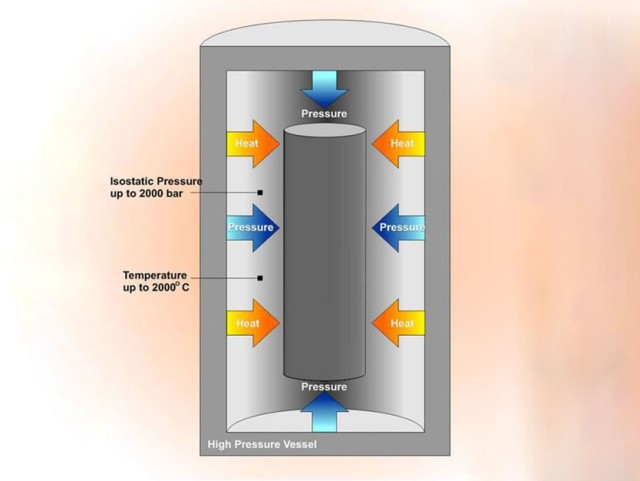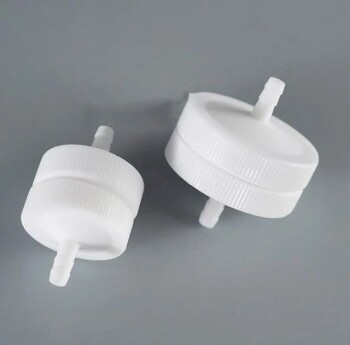Table of Contents
What is Hot Isostatic Pressing
Hot isostatic pressing is a versatile process that can be used on a wide range of materials, including metals, ceramics, and polymers. It is often used to improve the properties of materials for use in various applications, such as aerospace, automotive, and medical devices.
One of the benefits of HIP is its ability to uniformly compress materials, resulting in a more dense and homogenous structure. This can improve the strength and performance of the material in various applications. In addition, HIP can also be used to repair defects in solid materials, such as pores, voids, and cracks.
This can help to improve the overall quality and reliability of the material. Other benefits of HIP include the ability to produce complex shapes and improve the surface finish of materials.
It is similar to the process of hot pressing, but differs in that the gas pressure is uniformly distributed in all directions of the material during HIP, ensuring that the properties in different directions of the material are equal.
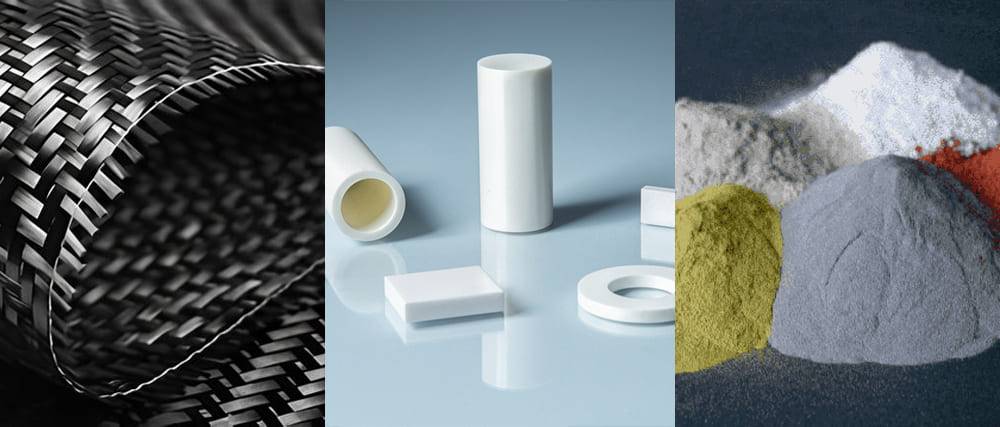
Advantages
Uniform strength
The uniform application of pressure during hot isostatic pressing (HIP) results in uniform strength in all directions of the material. This is in contrast to other manufacturing processes where the material may be stronger in some directions than others.
The uniform strength of materials processed through HIP can be beneficial in applications where the material will be subjected to stress or strain from multiple directions. In addition, the uniform strength of HIP-processed materials can also improve the overall performance and reliability of the material in various applications.
Improvement in mechanical properties
One of the benefits of hot isostatic pressing (HIP) is the improvement in mechanical properties of the materials that undergo the process. These properties include ductility, which is the ability of a material to deform under stress without breaking, and strength, which is the ability of a material to withstand applied forces.
The improvement in these properties can be attributed to the fact that HIP is able to eliminate defects such as pores, voids, and cracks in the material, which can weaken the overall structure of the material.
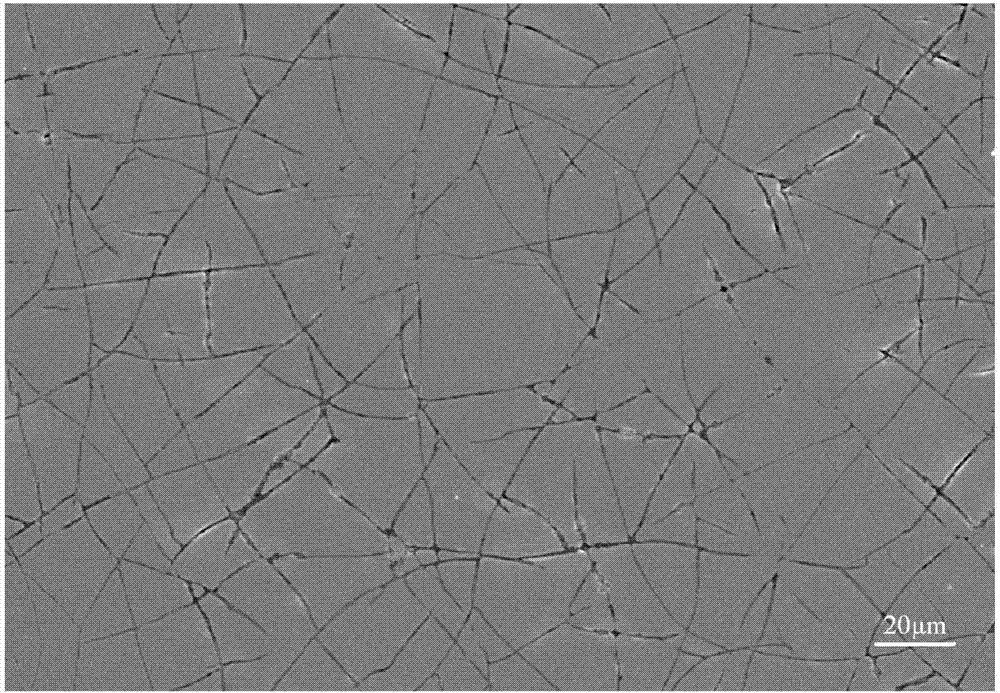
In addition, the uniform application of pressure during HIP can also improve the overall microstructure of the material, resulting in a stronger and more ductile material.
These improved mechanical properties can be beneficial in a variety of applications where the material will be subjected to stress or strain.
Improve the corrosion resistance
Hot isostatic pressing (HIP) can improve the corrosion resistance of materials, which can help to extend their lifespan. Corrosion is the degradation of a material due to chemical reactions with its environment, and it can significantly reduce the strength and performance of a material over time.
By eliminating defects and improving the microstructure of the material through HIP, the material becomes more resistant to corrosion and can withstand the effects of its environment for a longer period of time. This can be especially beneficial in applications where the material will be exposed to corrosive conditions, such as in the aerospace or automotive industries.
Cost-effective
Hot isostatic pressing (HIP) is a cost-effective process for improving the properties of materials. One reason for this is that the process produces high quality materials with improved density, strength, and microstructure. This can reduce the need for expensive quality assurance testing, as the materials produced through HIP are often of a higher quality than those produced through other manufacturing methods.
In addition, the extended lifespan of materials processed through HIP can also help to reduce costs by reducing the need for frequent material replacements. Overall, the cost-effectiveness of HIP makes it an attractive option for a variety of industries looking to improve the properties of materials in a cost-effective manner.
Improved microstructure
Hot isostatic pressing (HIP) can significantly improve the microstructure of materials. One of the benefits of HIP is the ability to produce a homogenous microstructure, where the structure of the material is uniform throughout.
This can be beneficial in improving the overall strength and performance of the material. In addition, HIP can also produce fine, unsegregated grains, which can further improve the strength and ductility of the material.
The improved microstructure of materials processed through HIP can be beneficial in a variety of applications where the material will be subjected to stress or strain.
The ability of HIP to improve the microstructure of materials is one of the key advantages of this manufacturing process.
Additional advantages
There are several additional advantages of hot isostatic pressing (HIP) beyond those already mentioned:
Enhanced surface finish: HIP can produce a smoother, more uniform surface finish on materials compared to other processes. This can be beneficial in applications where the material's surface finish is critical, such as in the aerospace and automotive industries.
Improved dimensional accuracy: HIP can help to improve the dimensional accuracy of materials, making them more precise and consistent in shape and size. This can be important in applications where precise tolerances are required.
Overall, hot isostatic pressing is a versatile and valuable tool for improving the properties of materials and has a wide range of advantages that make it an important manufacturing process in a variety of industries.
Applications
Hot isostatic pressing (HIP) is used to improve the density, strength, and microstructure of materials through the application of high temperature and pressure. It is a versatile process that can be used on a wide range of materials, including metals, ceramics, and polymers, and has a variety of applications in different industries. Some of the common applications of HIP include:
Sputtering Target Fabrication
Hot isostatic pressing (HIP) is a valuable tool for preparing sputtering targets, which are used in a variety of applications, such as thin film deposition and semiconductor manufacturing.
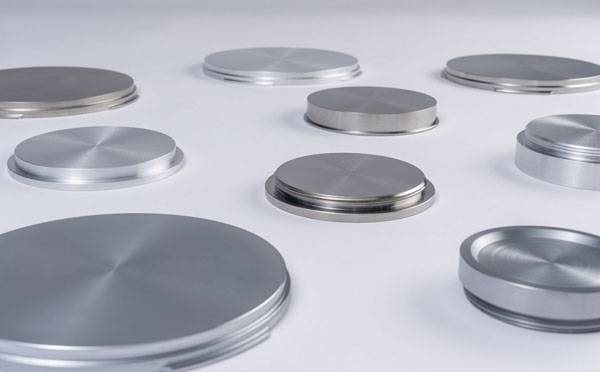
HIP is an excellent process for fabricating sputtering targets as it can significantly improve the density and reduce the porosity of the material, resulting in a more homogenous and high-quality final product.
In comparison to other processes such as conventional hot pressing, HIP can often produce superior results due to its ability to uniformly compress the material and eliminate defects. The improved density and homogeneity of HIP-processed sputtering targets can make them more suitable for use in various sputtering applications.
Medicine
Hot isostatic pressing (HIP) is frequently used in the medical industry to produce high-quality castings for surgical tools and medical implants, such as braces and joint replacements.
The process is able to improve the density and eliminate porosity from the materials, resulting in a more homogenous and strong structure.
The improved density and homogeneity of HIP-processed materials can help to improve the performance and reliability of the medical devices, making them more suitable for use in demanding medical applications. In addition, the elimination of porosity can also help to improve the corrosion resistance of the materials, helping to extend their lifespan.
Aerospace
Hot isostatic pressing (HIP) is frequently used in the aerospace industry to improve the density and eliminate porosity from castings used in aircraft engines and components. The process works by uniformly compressing the material and driving out any gases or other impurities that may be present, resulting in a more dense and homogenous structure.
The improved density of HIP-processed castings can help to improve their strength and performance in demanding aerospace applications. In addition, the elimination of porosity can also help to improve the corrosion resistance of the castings, helping to extend their lifespan and improve their overall reliability.
Diffusion Bonding
Hot isostatic pressing (HIP) can be used to join different materials through a process known as diffusion bonding. Diffusion bonding is a solid-state welding process in which two materials are joined together through the diffusion of atoms across the interface between the materials.
HIP can be used to facilitate this process by applying high temperature and pressure to the materials, which helps to accelerate the diffusion of atoms and promote the formation of a strong bond between the materials.
HIP can be used to join materials through a variety of techniques, including cladding (the application of a thin layer of material to a substrate) and welding. The process can be used to join a wide range of materials, including metals, ceramics, and polymers.
Sintering
Sintering is a manufacturing process in which a material is consolidated by heating it to a temperature below its melting point, causing the particles of the material to bond together. However, sintering can often produce materials with varying degrees of porosity, which can negatively impact their strength and performance.
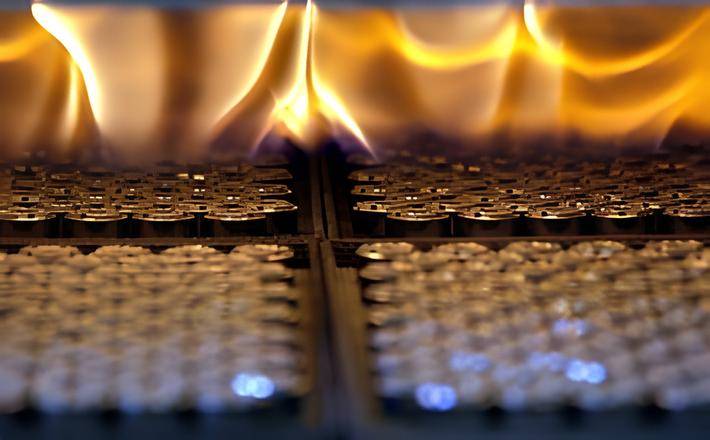
Hot isostatic pressing (HIP) is a useful tool for addressing this issue, as the process can help to eliminate porosity and improve the density of sintered materials. As a result, materials sintered through HIP are often stronger and more visually appealing than those produced through conventional sintering alone.
The improved density and reduced porosity of HIP-processed sintered materials can make them more suitable for use in a variety of applications, including in the aerospace, automotive, and medical industries.
3D Printing
3D printing of metals is becoming increasingly popular as a manufacturing method, and the combination of 3D printing with hot isostatic pressing (HIP) can further improve the quality of the metals produced. 3D printing is a process in which a material is built up layer by layer to create a three-dimensional object.
When 3D printing is combined with HIP, the process can help to improve the density, strength, and microstructure of the metals produced, making them more similar to those produced through more conventional manufacturing methods.
The improved properties of HIP-processed 3D printed metals can make them more suitable for use in a variety of applications, such as in the aerospace, automotive, and medical industries.
How to Improved Degree of Densification
The degree of densification, or the extent to which a material becomes more dense, that occurs during hot isostatic pressing (HIP) can vary depending on the specific material being processed. There are several factors that can influence the degree of densification in HIP, including:
Temperature
Temperature is an important factor in hot isostatic pressing (HIP) as it can influence the degree of densification that occurs during the process. Generally, higher temperatures result in a greater degree of densification. However, it is important to ensure that the temperature used for HIP is below the melting point of the material being processed, as exceeding the melting point can result in the material losing its integrity.
The ideal temperature range for HIP is typically between 1173 K and 2523 K, depending on the specific material and processing conditions being used. It is important to carefully control the temperature during HIP to ensure optimal results.
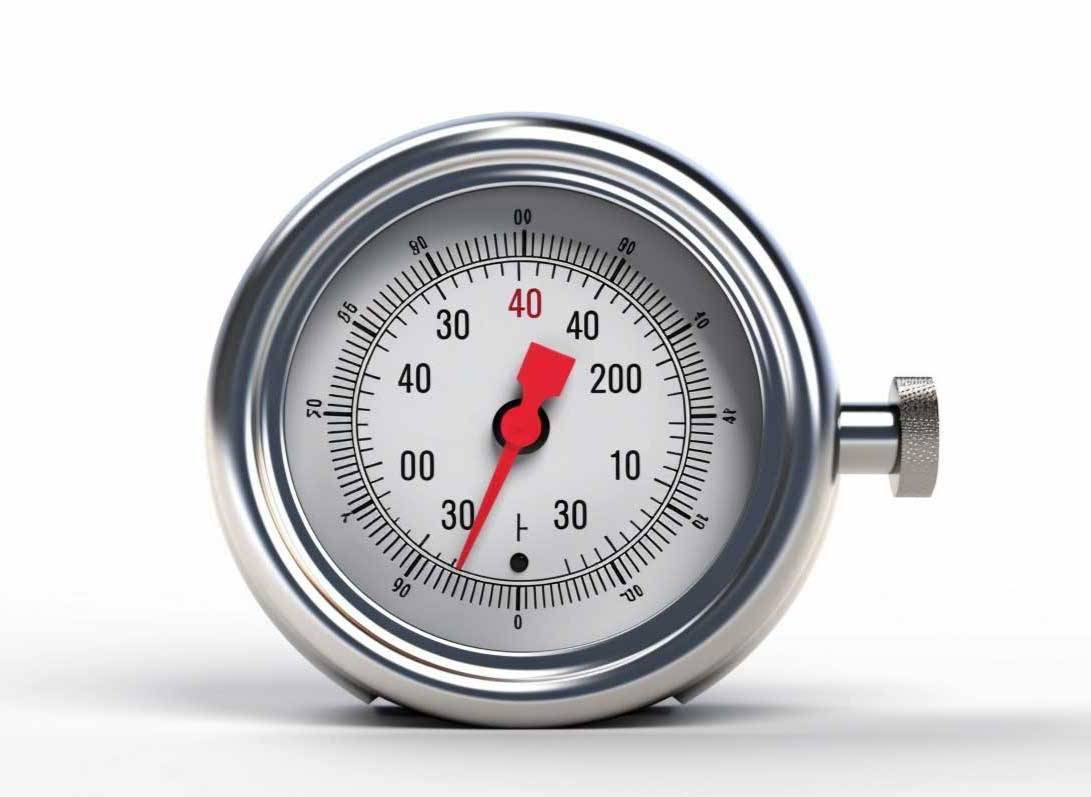
Time
The hold time, or the length of time that the material is subjected to the high temperature and pressure during hot isostatic pressing (HIP), can also influence the degree of densification that occurs. The hold time required for a material to be appropriately densified can depend on the thickness of the material, with thicker materials generally requiring a longer hold time than thinner materials.
In addition to the thickness of the material, the hold time can also be influenced by the specific material and processing conditions being used. It is important to carefully control the hold time during HIP to ensure optimal results and achieve the desired degree of densification.
Pressure
Pressure is an important factor in hot isostatic pressing (HIP) as it helps to uniformly compress the material and improve its density. The ideal pressure range for HIP is typically between 100 MPa and 200 MPa, depending on the specific material and processing conditions being used.
Argon is often used as the pressure medium in HIP, as it is an inert gas that can help to prevent reactions between the material and the pressure medium.
Lab Hot Isostatic Pressing Equipment
Features
There are several features that are commonly found in laboratory hot isostatic pressing (HIP) equipment:
- High-pressure vessel: The high-pressure vessel is the main component of the HIP equipment, where the material is placed and subjected to high temperature and pressure during the HIP process. The vessel is typically made of a strong and durable material, such as stainless steel, and is designed to withstand the high pressures and temperatures used in HIP.
- Temperature control system: The HIP equipment typically includes a temperature control system to regulate the temperature of the high-pressure vessel. This system may consist of heating elements, temperature sensors, and a control unit to accurately maintain the desired temperature.
- Pressure control system: The HIP equipment also includes a pressure control system to regulate the pressure applied to the material during the HIP process. This system may consist of a pressure gauge, pressure transducers, and a control unit to accurately maintain the desired pressure.
- Gas supply system: HIP typically involves the use of a gas, such as argon, to apply pressure to the material. The HIP equipment includes a gas supply system to deliver the gas to the high-pressure vessel and maintain the desired pressure during the HIP process.
- Safety features: Laboratory HIP equipment includes a variety of safety features to protect the operator and equipment during the HIP process. These may include pressure relief valves, safety interlocks, and protective shielding.
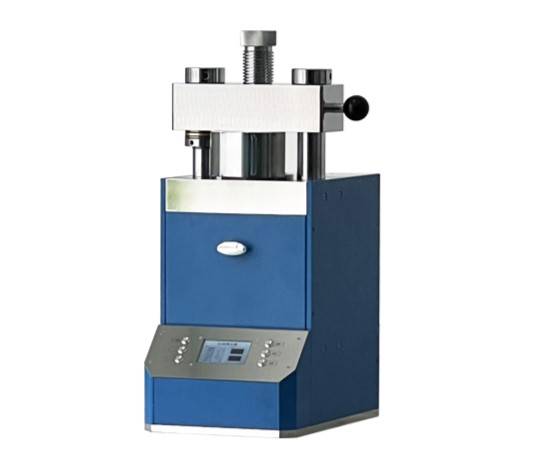
How to choose
There are several factors to consider when choosing laboratory hot isostatic pressing (HIP) equipment:
- Material compatibility: The HIP equipment should be compatible with the materials that you intend to process. This includes considerations such as the melting point and chemical compatibility of the material with the equipment.
- Process requirements: The HIP equipment should be capable of meeting the specific process requirements of your application, such as the required temperature, pressure, and hold time.
- Equipment capacity: The HIP equipment should have the capacity to accommodate the size and shape of the materials that you intend to process.
- Safety features: It is important to choose HIP equipment that includes a variety of safety features to protect the operator and equipment during the HIP process.
- Budget: Consider your budget when choosing HIP equipment and look for a balance between price and performance.
- Service and support: Look for HIP equipment from reputable manufacturers that offer good service and support, such as technical assistance and maintenance services.
Overall, it is important to carefully consider these factors when choosing HIP equipment to ensure that the equipment is suitable for your specific needs and application.
Related Products
- Automatic Lab Cold Isostatic Press CIP Machine Cold Isostatic Pressing
- Automatic High Temperature Heated Hydraulic Press Machine with Heated Plates for Lab
- Vacuum Induction Melting Spinning System Arc Melting Furnace
- Non Consumable Vacuum Arc Induction Melting Furnace
- HFCVD Machine System Equipment for Drawing Die Nano-Diamond Coating
Related Articles
- Additive Manufacturing for Isostatic Pressing: Bridging New Technology with Traditional Manufacturing
- Comprehensive Application of Cold Isostatic Pressing Technology
- Automatic isostatic press operation steps
- Principle and Process of Cold Isostatic Pressing
- Application of Hot Isostatic Pressing Technology in Special Ceramic Preparation
